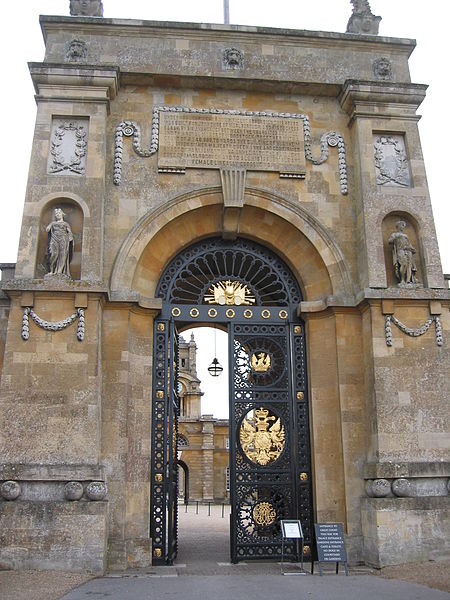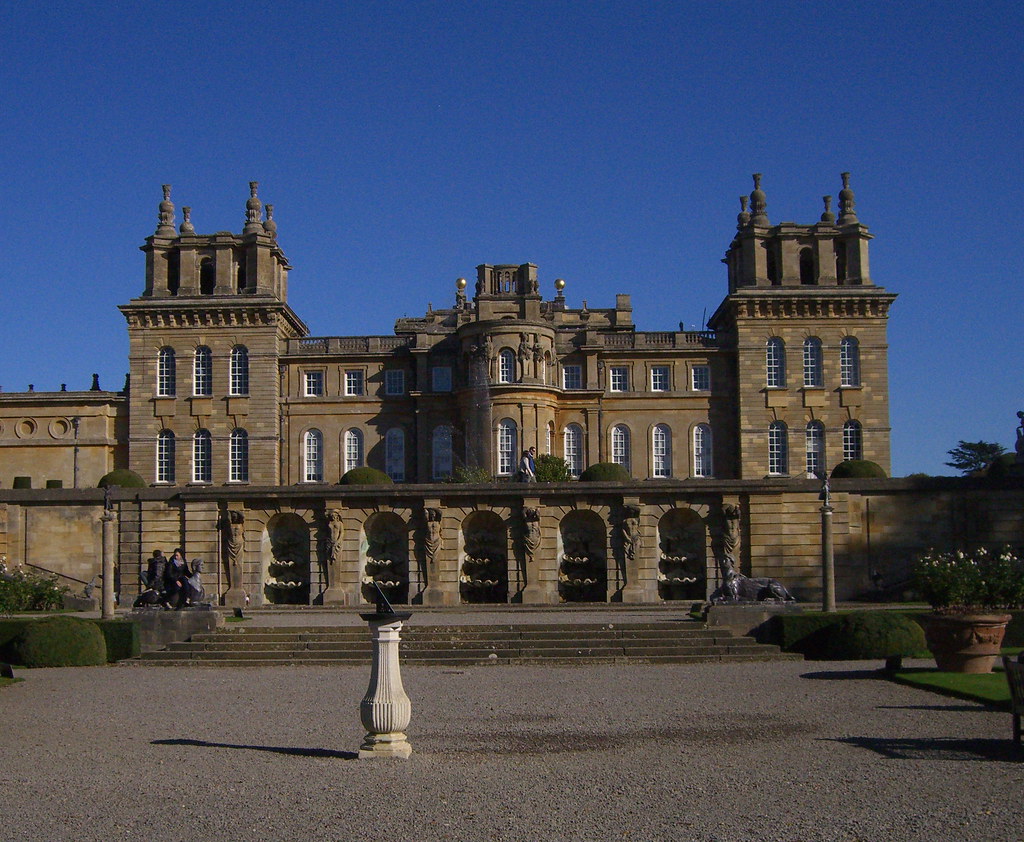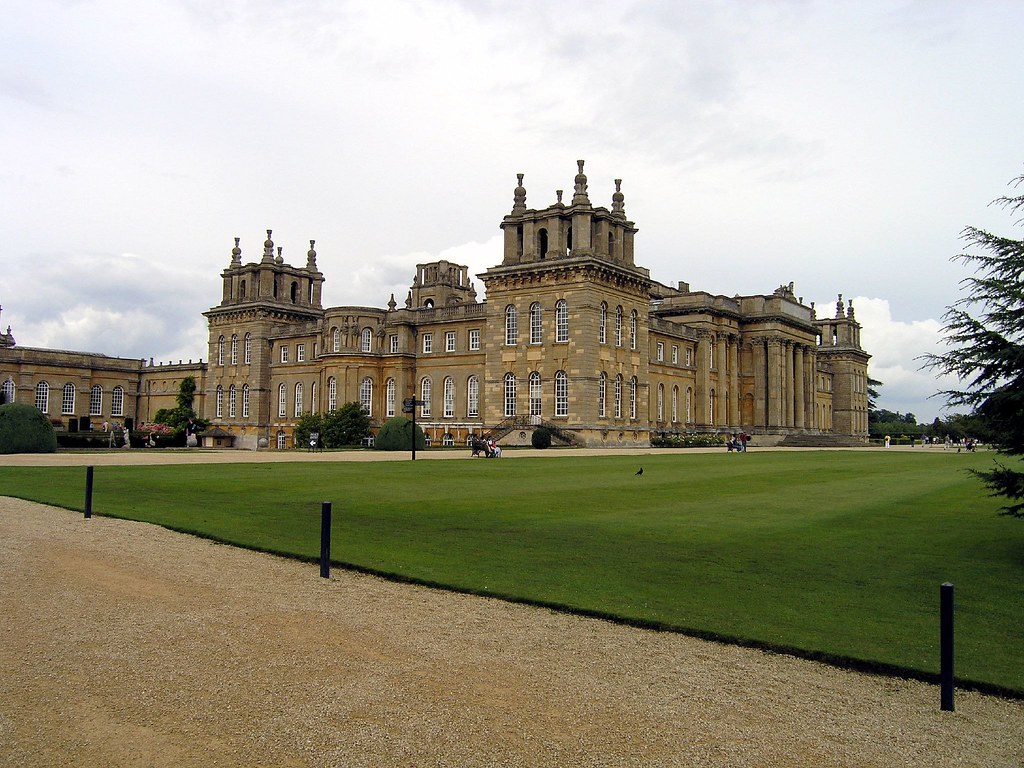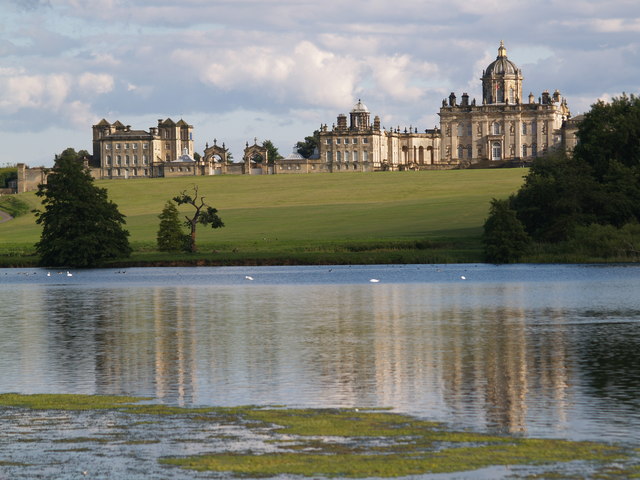.
Sir John Vanbrugh's south facade of Castle Howard, commissioned in 1699; residence of the Howard family, formerly the Earls of Carlisle, and filming location for the "Brideshead Revisted" miniseries (Yorkshire, England): photo by diverstonefly 29 August 2006
Under this stone, Reader, survey
Dead Sir John Vanbrugh's House of Clay.
Lie heavy on him, Earth! For he
Laid many Heavy Loads on thee!
Abel Evans (1679-1737): On Sir John Vanbrugh (The Architect). An Epigrammatical Epitaph (1726)

Sir John Vanbrugh's Temple of the Four Winds in the grounds of Castle Howard, near York: photo by Peter Astbury, 16 August 2010

Seaton Delaval Hall, seen from north: photo by Alan J. White, 17 April 2006

Architect Sir John Vanbrugh's Seaton Delaval Hall, begun 1718, completed 1728; central block seen from north: photo by Alan J. White, 16 April 2006

Vanbrugh's monumental East Gate at Blenheim Palace is more the entrance to a citadel than to a palace. Vanbrugh cunningly slightly tapered the sides to create an illusion of even greater height and drama: photo by Magnus Manske, 21 October 2005

Sir John Vanbrugh's West facade of Blenheim Palace ("Vanbrugh's castle air"), commissioned in 1704, showing the unique severe towering stone belvederes ornamenting the skyline: photo by Eljay, 25 October 2010

Blenheim Palace: photo by gail548, 13 August 2004










10 comments:
My favourite architect! and he wrote terrific plays too. There is also Kingsweston House in Clifton...
Americans view this
as a great place
to play frisbee
or toss the sac
beside the old
potato fields
too close
for comfort
crazy for spices, crazy
like crazy monkeys
chained to the sill
with no chance of escape
back to the ship
unnoticed; never again
held harmless; marooned
taking the place of peasants.
Horace Walpole was unimpressed by Blenheim Palace, describing it in a letter to George Montagu of 20 May 1736 as "'execrable within, without & almost all round... a quarry of stone that looked at a distance like a great house."
Voltaire, who inspected Blenheim in the Fall of 1727, thought it '"a great mass of stone with neither charm nor taste" and suggested ironically that if the apartments "were but as spacious as the walls thick, the house would be commodious enough."
Jacob Friedrich, Baron Bielfeld, a German visitor to Blenheim, reported his reactions in a letter on 10 March 1740: "This building (Blenheim) has been severely censured, and I agree that it is not entirely exempt from rational censure as it is too much loaded with columns and other heavy ornaments. But if we consider that Sir John Vanbrugh was to construct a building of endless duration, that no bounds were set to expense, and that an edifice was required that should strike with awe and surprise even at a distance; the architect may be excused for having sacrificed, in some degree, the elegance of design to multiplicity of ornament."
The nineteenth-century English architect Sir Robert Smirke, a proponent of the Greek Revival style that opposed itself to Vanbrugh's heavyweight version of English baroque, expressed a certain professional consensus: "Heaviness was the lightest of (Vanbrugh's) faults... The Italian style...which he contrived to caricature...is apparent in all his works; he helped himself liberally to its vices, contributed many of his own, and by an unfortunate misfortune adding impurity to that which was already greatly impure, left it disgusting and often odious."
Michael, Blogger, which has a mind (?) of its own, had consigned your good comment to spam... but I have now retrieved it, and am grateful to have some balance in the view.
Andrew Sanders calls Vanbrugh "a flamboyantly inventive architect... His buildings are brilliant, balanced, whimsical and weighty."
The historical dialectic of aesthetic taste stumbling along in the dark as it does, one period's airiness is another's gravity, which in turn... and so on.
As to the plays, I remember them as robust, funny, with comic figures (Sir Tunbelly and his daughter) that seem to have vaulted into the age of Congreve straight out of the age of Elizabeth.
If Sir John had been a Greek buried on Greek soil, the mourners at the cemetery would have been heard to say "Let the earth that covers him be light."
Ha!
I love the conception of cosmic justice hinted at in this bluntly disrespectful epigrammatical epitaph -- the roughness of the epitaph only partially excused by the harshness of the genre. The heavier one weighs upon the earth, the heavier it will weigh upon one. Just imagine that formula being applied to the powerhouse businessmen, politicos, entrepreneurs -- not to mention the academic racketeers of "the arts" -- of the present era.
Atlas Shrugged?
Peel
We prayed for an elixir. It arrived
about the size of a knuckle,
then a hand. Hearty tuber.
Digging for it, I found gold,
under that float field.
It divided us up
into rich and poor.
We wanted more
waiting in the deep
dank earth
sparkling with little eyes
sending up shoots
spies, purple flowers
purple stars.
They can rent the dirt
tell them
how to eat it.
Yes, I see the perfect place for a murder. It happened in the potato patch. The crime was hunger. The victim turned out to be Peru, yet again, and only recently mentioned in the papers.
I like seeing what the Brits have done restoring the old henge, here. Lots of extras.
Post a Comment